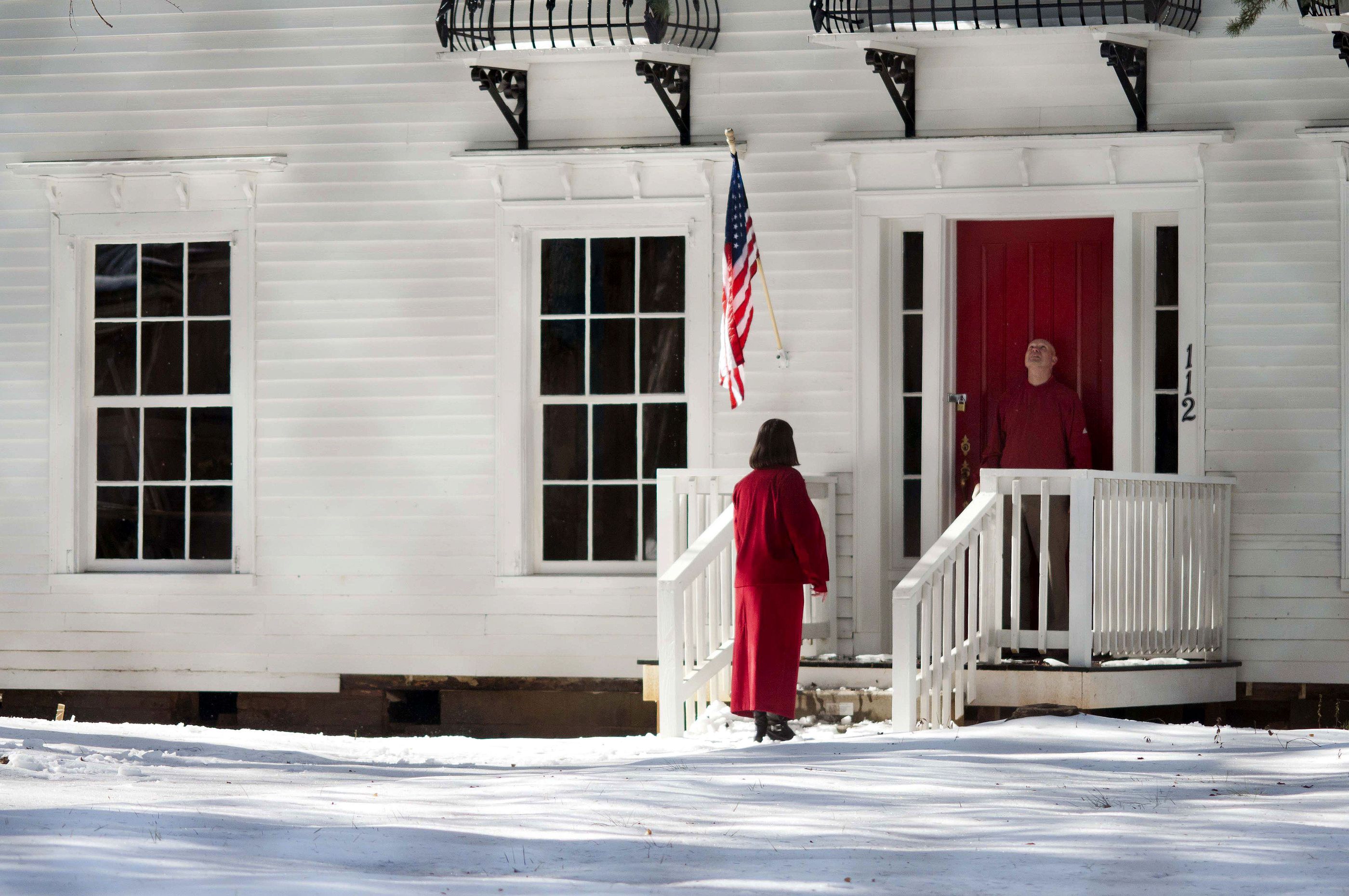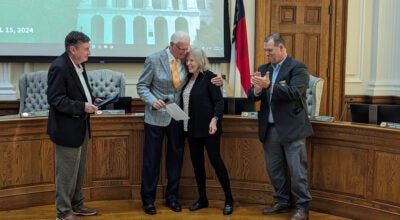Dixons purchase their ‘forever home,’ the historic Blackmer House
Published 12:00 am Saturday, February 15, 2014
SALISBURY — Glenn and Beth Dixon bought one of Salisbury’s most historic houses Friday when they signed closing documents on the Fulton-Mock-Blackmer House at 112 S. Fulton St.
“This is our forever home,” Glenn Dixon said. “At one point, if we live here long enough, it could be the Fulton-Mock-Blackmer-Dixon House.”
Historic Salisbury Foundation sold the 1820 house for $150,000, and now the Dixons will begin a bottom-to-top restoration, which by any measure, will be challenging.
Realizing it’s an ambitious goal, Beth Dixon said she hopes her family can make the house their new residence by Christmas.
The house encompasses 4,800 to 5,000 square feet. It has four chimneys and eight fireplaces. Once it becomes a residence again, it will afford four bedrooms and two bathrooms upstairs.
The Dixons plan to add a master bedroom downstairs, and they also will be bringing back the once grand porch/portico in front, which featured four full columns.
The Dixons will count on contractor Al Wilson and architect Jon Palmer to guide the restoration. The couple also want to accomplish as much of the project as possible this year, because N.C. historic preservation tax credits available for this property are scheduled to sunset Jan. 1, 2015.
The project will qualify for residential tax credits of 30 percent. Glenn Dixon said the couple would not have considered buying the house without the tax incentive.
The house, once owned by famed film and stage actor Sidney Blackmer and his wife, Suzanne, was severely damaged in a 1984 fire.
Evidence of the fire can be seen throughout the interior, especially the second floor. Whole walls and stairways are charred, and in a few places, only remnants of walls remain.
For years, the house had stayed shuttered and overrun by vegetation and varmints, until the foundation’s successful third attempt at a purchase July 2, 2012.
“Even in the state it’s in, it’s beautiful,” Beth Dixon said Friday. “You have to have a vision, and we do. We can see it restored.”
ggg
In 2012, the foundation bought the home from Jonathan Blackmer, Sidney and Suzanne’s oldest son, for $109,611.
The Dixons said the foundation’s cleanup of the property, led by Doug Black, made it possible for them to see the house’s potential for restoration when their family first visited the site the Saturday after New Year’s Day.
“The foundation did so much work,” Beth Dixon said. “It was such a community effort to save this house.”
The couple returned to the property at least four other times. They also had professional input, while HSF Executive Director Brian Davis kept assuring them a restoration into a modern-day home with all of its historic character intact was possible.
Meanwhile, both parties — the foundation and the Dixons — laid their cards on the table. The foundation basically wanted to recoup its investment and make sure the historic home was saved, while the Dixons showed the budget they had to work with and asked, “Can we do it?”
ggg
The Dixons are not strangers to this West Square Historic District, nor taking on a house’s transformation. In 1996-98, they restored a historic home in the 300 block of South Ellis Street.
They later moved to the Country Club area. Returning to the West Square and being close to the downtown was important to them, Beth Dixon says.
“We are just thankful to be back in the neighborhood,” she added.
The Dixons have four children — two sons in college and twin daughters who are seniors in high school.
Because Glenn spends considerable parts of the week working for the State Department in Washington, D.C., Beth expects to be the point person during the restoration.
The couple hope Wilson, their contractor and a good Scouting friend of Glenn’s, will find weekend and summer vacation projects the family can take on in connection with the house.
Dixon, a District Court judge, says she is more of a closer or finisher in this type of project, following through on many of the details after all the renovations take place.
ggg
Glenn Dixon said it actually will be an advantage in the major reconstruction to come that the house is more or less a shell. New infrastructure such as plumbing, wiring, heating and air-conditioning will be easier to install.
The house is full, however, of evidence or clues to its original construction, details such as wallpaper, paint colors, windows, siding, moldings, baseboards, door frames, chair rails and mantels.
Beth Dixon said the restoration will remain as true to the original footprint as possible.
Davis, the HSF executive director, said all four of the house’s chimneys will come down and go back up. But the new chimneys will use the old bricks as a facade, encasing higher-density bricks inside to serve as the chimneys’ fireboxes.
The house’s impressive columns survived the 1984 fire and for years were stored inside the house on the first floor. Wilson already has started work on two of the columns.
Relying on an anonymous donation, Wilson replaced the roof on the Blackmer House after the 1984 fire, and Davis said the house could not have survived without it.
Black, the HSF property manager, credited city leaders, the foundation and tolerant neighbors through the years for saving the house.
“It will be a wonderful day when the chain-link fence can come down,” Beth Dixon said.
ggg
The Dixons said the house’s history is important to them, from Fulton to Blackmer.
John Fulton, for whom Fulton Street and the Fulton Masonic Lodge are named, originally bought the property in 1803.
Davis said he apparently first built a home closer to the street and lived there until the 1820 structure was constructed. Archeological digs uncovered some artifacts in the Blackmer House’s front yard that would normally be in a home’s back yard, Davis noted.
The 1820 structure served as Fulton’s residence and a boarding house for girls attending the female academy at the Hall House.
Fulton died in 1827, and the property passed to his stepson Maxwell Chambers. At one time, before its eventual purchase by A.J. Mock, the house was deeded to Davidson College.
Blackmer, a Salisbury native, bought the house in 1931, and he planted the tall cedars, holly tree and magnolia noticeable from Fulton Street.
Blackmer, who died in 1973, won a 1950 Tony as best actor for his role in “Come Back, Little Sheba.” He portrayed President Teddy Roosevelt in more than a dozen films.
In 1937 alone, he appeared in 12 movies, including “Heidi” with Shirley Temple. He won acclaim for his portrayal of Boss Finley in Tennessee Williams’ “Sweet Bird of Youth” with Paul Newman and as the Satan-worshipping warlock in the 1968 movie, “Rosemary’s Baby.”
Suzanne Blackmer also acted in at least 40 films, including “The Great Ziegfeld,” “The Devil Bat” and several Three Stooges movies.
ggg
Because their daughter Susannah has a role in the current Piedmont Players’ production of “The Count of Monte Cristo,” the Dixons secured a copy and watched the 1934 movie of the same name, in which Sidney Blackmer had an important role.
Glenn Dixon also surprised his wife before they attended the play’s premiere Friday night by setting up a table with flowers, wine and pizza in the Blackmer House’s dining room.
The couple said they did not purposely plan to close on this house on Valentine’s Day, though it was a nice bonus.
Beth Dixon grew up in a military family constantly on the move, so she really never considered a place her hometown until she and Glenn moved to Salisbury 21 years ago.
She gets the same kind of feeling now from the Fulton-Mock-Blackmer-Dixon House.
“It just feels like home,” she said.
Contact Mark Wineka at 704-797-4263.






